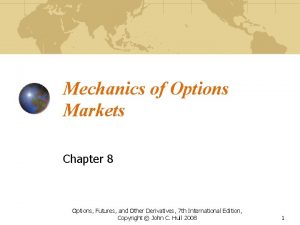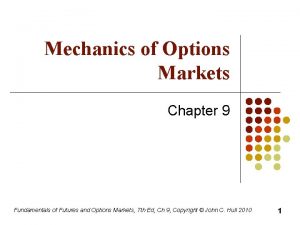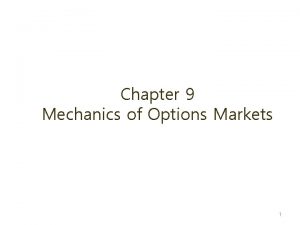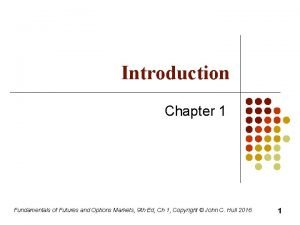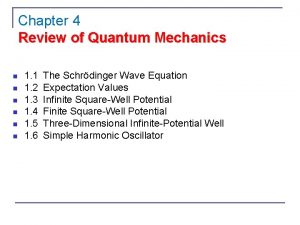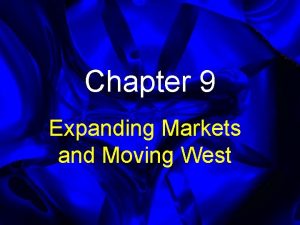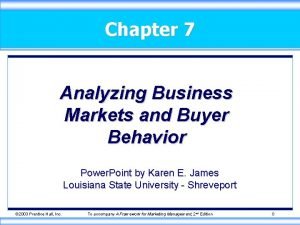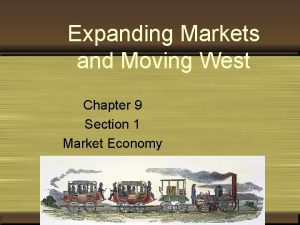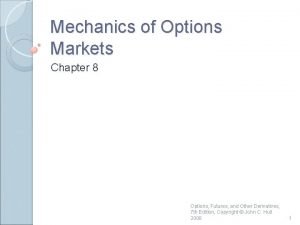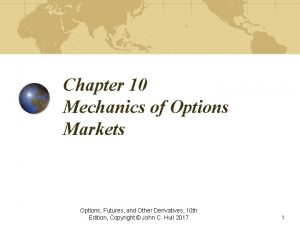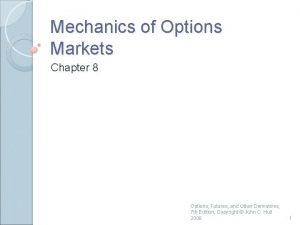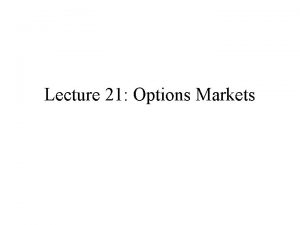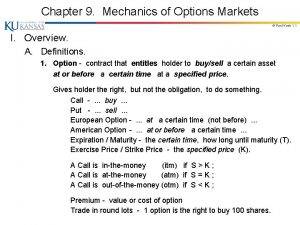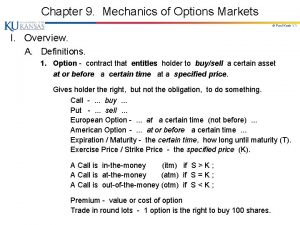Chapter 9 Mechanics of Options Markets 1 Review




















- Slides: 20

Chapter 9 Mechanics of Options Markets 1

Review of Option Types • A call is an option to buy • A put is an option to sell • A European option can be exercised only at the end of its life • An American option can be exercised at any time 2

Option Positions • • Long call Long put Short call Short put 3

Long Call (Figure 9. 1, Page 195) Profit from buying one European call option: option price = $5, strike price = $100, option life = 2 months 30 Profit ($) 20 10 0 -5 70 80 90 100 Terminal stock price ($) 110 120 130 4

Short Call (Figure 9. 3, page 197) Profit from writing one European call option: option price = $5, strike price = $100 Profit ($) 5 0 -10 120 130 70 80 90 100 Terminal stock price ($) -20 -30 5

Long Put (Figure 9. 2, page 196) Profit from buying a European put option: option price = $7, strike price = $70 30 Profit ($) 20 10 0 -7 Terminal stock price ($) 40 50 60 70 80 90 100 6

Short Put (Figure 9. 4, page 197) Profit from writing a European put option: option price = $7, strike price = $70 Profit ($) 7 0 40 50 Terminal stock price ($) 60 70 80 90 100 -10 -20 -30 7

Payoffs from Options What is the Option Position in Each Case? K = Strike price, ST = Price of asset at maturity Payoff K K ST ST 8

Assets Underlying Exchange-Traded Options Page 198 -199 • • Stocks Foreign Currency Stock Indices Futures 9

Specification of Exchange-Traded Options • • Expiration date Strike price European or American Call or Put (option class) 10

Terminology Moneyness : – At-the-money option – In-the-money option – Out-of-the-money option 11

Terminology (continued) • Option class • Option series • Intrinsic value • Time value 12

Dividends & Stock Splits (Page 202 -204) • Suppose you own N options with a strike price of K : – No adjustments are made to the option terms for cash dividends – When there is an n-for-m stock split, • the strike price is reduced to m. K/n • the no. of options is increased to n. N/m – Stock dividends are handled similarly to stock splits 13

Dividends & Stock Splits (continued) • Consider a call option to buy 100 shares for $20/share • How should terms be adjusted: – for a 2 -for-1 stock split? – for a 5% stock dividend? 14

Market Makers • Most exchanges use market makers to facilitate options trading • A market maker quotes both bid and ask prices when requested • The market maker does not know whether the individual requesting the quotes wants to buy or sell 15

Margins (Page 205 -206) • Margins are required when options are sold • When a naked option is written the margin is the greater of: – A total of 100% of the proceeds of the sale plus 20% of the underlying share price less the amount (if any) by which the option is out of the money – A total of 100% of the proceeds of the sale plus 10% of the underlying share price (call) or exercise price (put) • For other trading strategies there are special rules 16

Warrants • Warrants are options that are issued by a corporation or a financial institution • The number of warrants outstanding is determined by the size of the original issue and changes only when they are exercised or when they expire 17

Warrants (continued) • The issuer settles up with the holder when a warrant is exercised • When call warrants are issued by a corporation on its own stock, exercise will usually lead to new treasury stock being issued 18

Employee Stock Options (see also Chapter 15) • Employee stock options are a form of remuneration issued by a company to its executives • They are usually at the money when issued • When options are exercised the company issues more stock and sells it to the option holder for the strike price • Expensed on the income statement 19

Convertible Bonds • Convertible bonds are regular bonds that can be exchanged for equity at certain times in the future according to a predetermined exchange ratio • Usually a convertible is callable • The call provision is a way in which the issuer can force conversion at a time earlier than the holder might otherwise choose 20
 Mechanics of options
Mechanics of options Mechanics of options markets
Mechanics of options markets Mechanics of options markets
Mechanics of options markets Fundamentals of futures and options markets
Fundamentals of futures and options markets Mechanics of futures markets
Mechanics of futures markets Mechanics of futures markets
Mechanics of futures markets Mechanics of futures markets
Mechanics of futures markets Chapter review motion part a vocabulary review answer key
Chapter review motion part a vocabulary review answer key Normalize wave function e^ix
Normalize wave function e^ix Why study financial markets?
Why study financial markets? Cultural dynamics in assessing global markets
Cultural dynamics in assessing global markets Characteristics of consumer behavior
Characteristics of consumer behavior Chapter 9 expanding markets and moving west
Chapter 9 expanding markets and moving west Analyzing business markets chapter 7 ppt
Analyzing business markets chapter 7 ppt Chapter 6 business markets and business buyer behavior
Chapter 6 business markets and business buyer behavior Chapter 18 the markets for the factors of production
Chapter 18 the markets for the factors of production Types of buyer behavior
Types of buyer behavior Analyzing consumer markets chapter 6
Analyzing consumer markets chapter 6 Chapter 5 consumer markets and buyer behavior
Chapter 5 consumer markets and buyer behavior Firms in competitive markets chapter 14 ppt
Firms in competitive markets chapter 14 ppt Chapter 9 expanding markets and moving west
Chapter 9 expanding markets and moving west
